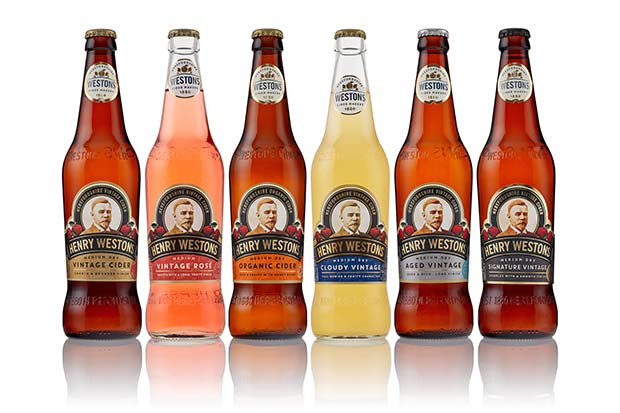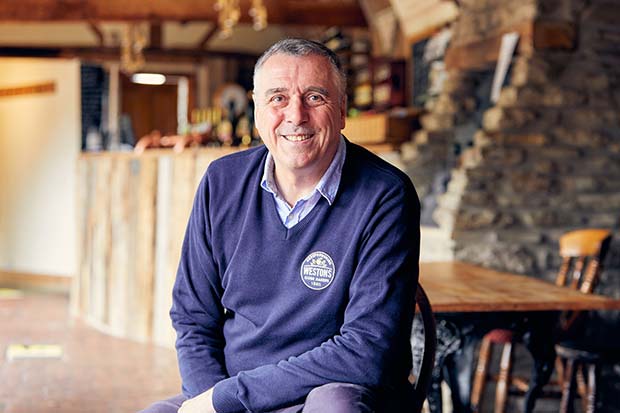The UK off-trade cider market has seen phenomenal growth over the last year and is now worth a record-breaking £1.3bn.
 With pubs, bars and restaurants closed for a large portion of 2020, consumers had a quiet night in, bringing nearly a million more shoppers into the category.
With pubs, bars and restaurants closed for a large portion of 2020, consumers had a quiet night in, bringing nearly a million more shoppers into the category.
Crafted cider is growing faster than the overall category and there is demand for new variants such as Cloudy and Rosé.
Darryl Hinksman, Head of Business Development at Westons Cider, tells Wholesale Manager how business has been during Covid-19 and how wholesalers can merchandise cider in-depot.
What is your background? How long have you been at Westons and where did you work before that?
I have spent nearly five years at Westons Cider where I’ve focused on driving growth and opportunities for the business – this has included partnering with the New Zealand Ginger Beer Ranga and overseeing the launch of Stowford Press Mixed Berries in both on and off trade. Immediately, prior to that, I was Sales & Marketing Director at Purity Brewing for three years, and before that, I was at Heineken where my last two roles were Head of Customer Marketing and Trading Director On-Trade.
Tell us about your role. What is a typical day for you?
In my role as Head of Business Development I deal with all our current and any potential partners. Currently, we are developing the New Ventures side of our business whereby we look to work with international partners whose brands and company ethos fit well with ours and where we can use our established infrastructure to represent them in the UK.
I’m closely involved in all aspects of communications between Westons Cider and our trade customers – that might mean speaking to journalists to share my thoughts on the cider market or the Westons business. This tends to be more of a focus in spring and early summer, as this is when people start to think about cider more seriously again. In addition, we have a full NPD pipeline, and most days will involve meetings related to one of those projects.
A typical day, as MD of our business in Australia, will begin with a conference call to one of the team down under – I catch them towards the end of their working day as I’m just starting mine. Typically, we talk about sales issues, NPD and anything else that has cropped up that may need attention.
Most days of the week I have an informal meeting with our MD, Helen Thomas, where I share anything I think she needs to be aware of – this catch up can be anything from five minutes to a couple of hours depending on what’s going on. I also have 1-2-1 sessions with my direct reports every week, so one of those will be scheduled most days. In general, no two days are the same and it’s great to be able to talk to a diverse mix of people both within the business and in our partners.
Can you give us an overview of the company’s brands?
At Westons, we pride ourselves on offering premium quality ciders created by our fifth-generation cider makers from locally sourced apples, gathered from the 50 miles around our Herefordshire mill.
Our portfolio ranges from traditional to contemporary and includes Stowford Press, Old Rosie, Mortimer’s Orchard, Rosie’s Pig, Caple Rd, Wyld Wood Organic Cider and, of course, our best-selling Henry Westons brand – now worth £63.1M in total retail up +37.8% YOY1. We also offer a comprehensive range of pack formats to cater for every occasion and our customers in both pubs, bars and restaurants, and in grocery retail.
What is the value of the UK cider market?
Over the past year, the off-trade UK cider market has experienced extraordinary growth and is now worth a record-breaking £1.3bn, accounting for 83% of total cider volume.2
While the enforced closure of pubs, bars and restaurants for much of 2020 certainly played a part in the category’s off-trade success – as consumers swapped trips to their local for a ‘quiet night in’ and almost a million more shoppers bought in to the category – premiumisation has also been a catalyst of category growth. We are increasingly seeing shoppers redirect some of their spend towards high quality, crafted ciders, in a bid to recreate the ‘perfect serve’ from home with premium offerings.
It is paramount that wholesalers and retailers recognise the opportunity for growth within the cider category and stock a range of products that cater for these new consumer preferences.
 What trends are driving the market?
What trends are driving the market?
As I mentioned, premiumisation continues to be the driving force for growth across the off-trade, with the average price per litre having risen to £2.31. In the convenience channel, this is already averaging £2.40, ahead of the total market.
Within this, crafted cider is significantly outpacing the overall category (up 48.7% versus 21.2%3). This can be largely attributed to the role this subcategory plays in driving premiumisation, as the price per litre of crafted cider is considerably higher than the market average (£3.23/L versus £2.31/L).
Furthermore, we are seeing a significant appetite for new offerings, such as Cloudy and Rosé, which now represent a huge sales opportunity respective growth rates of 104.1% and 481.3%4.
These higher-value sub-categories continue to drive trade-up and have become especially important over the past year as consumers looked to authentic, heritage brands for products they could count on to deliver a high-quality serve at home.
As the world begins to re-open, understanding cider drinkers’ motivations and the new opportunities beyond Covid will be crucial for wholesalers and retailers looking to maximise sales.
How has business been for Westons during Covid-19?
As a producer we control our supply chain from start to finish, which meant we were in a fortunate position to swiftly adapt to the changing retail landscape and the challenges of the pandemic.
For example, we quickly re-directed our focus from on-trade to off-trade to keep supplies where they needed to be and ramped up our support for retail in anticipation of what might happen, early last year. This meant that we stopped keg production, changed our shift pattern and started on 24-hour production of our best-selling Henry Westons range.
Beyond increased demand, suppliers have had to adapt to changing consumer behaviour. As a result of Covid-19, people are visiting supermarkets less frequently but spending more each time they go. This is also being supplemented by extra top-up shops in convenience stores and more online purchases.
For us, this meant refocusing our activity to support retailers across their dotcom platforms and providing them with premium, branded lines with provenance and heritage that will help them unlock sales opportunities. At a time when everyone has been shopping and drinking differently, premiumisation has continued to drive growth and our Henry Westons range was well positioned to drive incremental sales for retailers throughout a challenging period.
What advice do you have for wholesalers on merchandising cider in depot?
Cider is showing significant growth across multiple channels meaning there’s a clear opportunity for wholesalers to grab their share of the huge sales opportunity which the cider category presents. In the current climate, this means making the bestsellers the biggest priority, as these products are going to sell-through and drive value growth. A great example of this is our Henry Westons Vintage which is worth £56.5 million and growing +30.7% year-on-year5.
In general, wholesalers would do well to weight stock in line with the cider market to maximise sales. The latest data shows that apple and fruit ciders continue to dominate, accounting for 60% and 35% of total off-trade sales respectively – with pear ciders now accounting for just 5% of sales6.
Therefore, apple and fruit ciders should take priority in the cider fixture, and bestsellers like Henry Westons Vintage are crucial. As fruit ciders account for a third of overall sales, they should take up approximately one third of the shelf space in-depot.
When looking at formats, larger packs are performing particularly strongly as consumers have reverted to fewer, higher spend shops in the wake of the pandemic. For example, ten packs have increased +40% YOY with our Stowford Press ten pack growing by 540% last year7. That said, single bottles still make up the majority of cider market value, with a 40% share, meaning wholesalers must prioritise placement and visibility of these products in-depot to drive value sales.
To capitalise on the cider opportunity, wholesalers should adapt their ranges in line with changing consumer behaviour and the most popular products and formats.
How do you work with wholesalers to improve sales?
We spend a lot of time providing tailored merchandising and range review advice, as well as introducing new products, in order to help our wholesale customers maximise their cider sales.
Our Henry Westons brand is by far the largest glass bottled apple cider in the UK8 and its continued popularity highlights the growing appetite for premium, traditional ciders. That’s why, last year, we expanded our brand to include three new exciting variants: Henry Westons Vintage Rosé, Henry Westons Cloudy Vintage, and Henry Westons Organic Cider.
By expanding the portfolio – and building on the success of the fast-growing Henry Westons Vintage– we are continuing to diversify our offerings and provide wholesalers with authentic, premium and high-quality choices within popular cider sub-categories.
Do you have any NPD coming up?
We’re always looking for ways to innovate and keep our portfolio of premium ciders exciting for consumers and our retailer and wholesaler partners. While I can’t reveal too much at this stage, we have some exciting new products in the pipeline which we look forward to sharing with you in due course.
What marketing support do you have planned?
We’ll continue to work closely with retailers and wholesalers at key moments throughout the year to boost brand awareness and drive sales. This will include outdoor media, secondary space display and serve inspiration.
However, it’s important for wholesalers to remember that, although cider is commonly perceived to be a seasonal drink, the cider category – and apple cider in particular – continues to perform strongly throughout the winter months.
For maximum profit, it’s really a case of ensuring that cider as a category isn’t disadvantaged through the winter months in terms of shelf space and visibility. We would encourage wholesalers to ensure that they are stocking the bestsellers and devoting sufficient space in-depot to the category – not just during the upcoming seasonal cider period, but throughout the year.




Comments are closed.